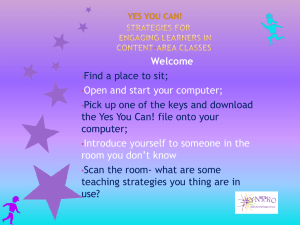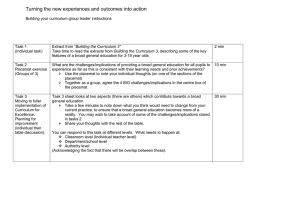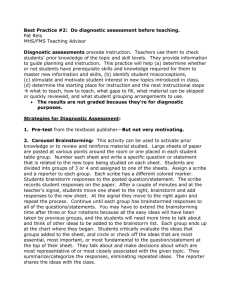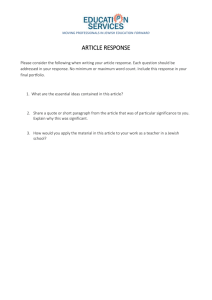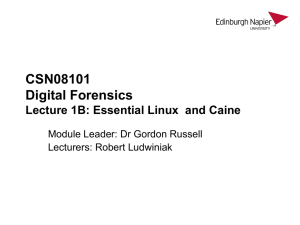When I die, I hope it is during a staff meeting
advertisement
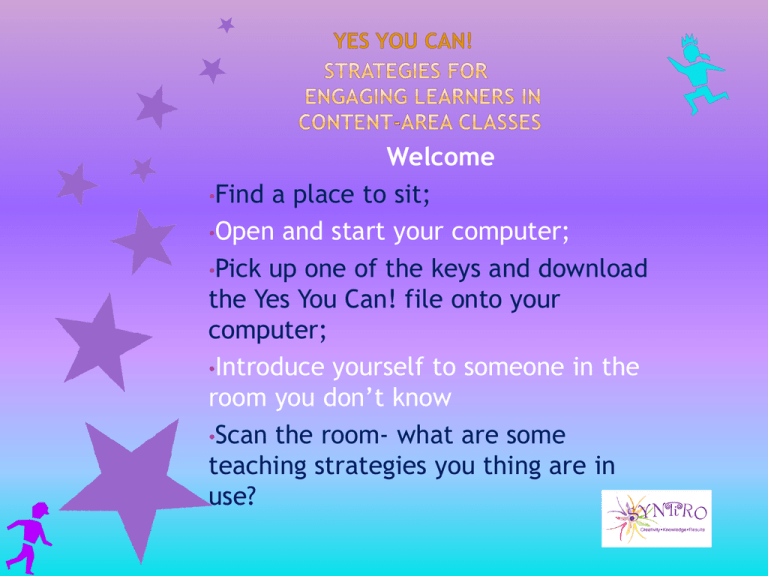
Welcome •Find a place to sit; •Open and start your computer; •Pick up one of the keys and download the Yes You Can! file onto your computer; •Introduce yourself to someone in the room you don’t know •Scan the room- what are some teaching strategies you thing are in use? Pamela Flood Syntiro February 2, 2011 None of us is as smart as all of us! David & Roger Johnson Hand Up Finish Your Sentence Stop Talking, Stop Doing Eyes on the Facilitator Signal Teammates Signal Other Teams Actively Listen Steve & Sybil Wolin Marian Leslie Hart Diamond Robert Sylwester Renata & Geoffrey Caine Pat Wolfe Eric Jensen William Glasser Horham Maslow David M. Kiersey Isabel Briggs Myers Bernice McCarthy 4-MAT Tony Gregoric Judy Wood Kathleen Butler Diane Loomans Karen Kolberg Brain Research Basic Needs Personality Types Laughing Classroom Humor & Resiliency Spencer Kagan Celebratory Learning Multiple Intelligences Rita & Ken Dunn David Lazear Susan Kovalik Thematic Integrated Instruction James A. Beane Problem Based Learning Wendy Mobilia Universal Design Differentiated Instruction Education by Design CAST Gayle Gregory Diane Heacox Technology Howard Gardner Thomas Armstrong David & Roger Johnson Cooperative Learning Curriculum Design Learning Styles Environment al Influences H. Stephen Glenn Jane Nelson Carolyn Chapman Links Daniel Goleman Carol Ann Tomlinson Open up your Yes You Can File In this file you have the teacher powerpoint Student Powerpoint Most of the handouts ********************************************************** For this workshop – please open you student powerpoint file. You will use this file to fill in the blanks – a way to keep students connected – allow for Opportunities to Respond… Success for today will look, sound, and feel like… Experiencing and learning about engaging cooperative learning structures; Understanding of research-based strategies to promote personal and share learning and responsibility; New ways to utilize cooperative learning strategies to promote deep learning in content dense subject areas; Fun ideas and a new strategy to use tomorrow! Welcome Goals Working Teams Exploring Research: Learning/ Meeting Styles and Needs Brain-Based Learning Cooperative Learning Strategies Research into Practice Strategies to engage Learners in Contentdense material Closing Personal Connections to 4 Styles of Learning; Exploring 3 the 12 Mind Brain Learning Principles; Conditions of Learning; Learn how cooperative structures can support the principles and conditions of learning. Deeper understanding of the conditions that support learning by attending to the emotional, physical needs, styles and preferences of learners. Step 1 - Mix-when the music starts move around room like cold water molecules (take at least 10 steps) Step 2 - Freeze - When the music stops – stop where you are and listen for the question Step 3 - Group by the # in the answer Question: How many feet does a biped have? Starting with the person’s head that is closest to the ceiling -Introduce yourselves… Then… Share what is written on your strip of paper and using Fist to 5 describe your level of understanding When the music starts move again… Question: How many syllables does anatomy have? Starting with the person’s head that is farthest from the ceiling -Introduce yourselves… Then… Share what is written on your strip of paper and your level of understanding (fist to 5) - 30 seconds each person This is your base team for the rest of this session. Collect your belongings and find a learning place for your team. Wait until all team members are present before you sit down. A B C D A’s and B’s are Shoulder Partners C’s and D’s are Shoulder Partners A’s and C’s are face Partners B’s and D’s are face Partners A B C D A – Facilitator B – Recorder C – Time Keeper D – Runner Visual Learners -generally think in terms of pictures and prefer to see things written down in a handout, text or on the overhead. They find maps, graphs, charts, and other visual learning tools to be extremely effective. They remember things best by seeing something written. Auditory Learners - learn best by listening. They typically like to learn through lectures, discussions, and reading aloud. They remember best through hearing or saying items aloud. Kinesthetic Learners - learn best through touching, feeling, and experiencing that which they are trying to learn. They remember best by writing or physically manipulating the information. Retrieved from http://712educators.about.com/od/learningstyles/a/learning_styles.htm Sensing people pay close attention to data provided by their senses -- immediate experience, literal facts, and close realities. Action Is What Drives Them Intuitive people need to find associations and connections among things and are interested in theories and imagined possibilities. Meaning Is What Drives Them Thinking people prefer logic and orderly, analytic, and objective thinking. Structure Is What Drives Them Feeling People prefer subjective thinking connected with human values and harmony. Caring Is What Drives Them http://psychology.about.com/od/educationalpsychology/ss/jung-styles.htm Carl Jung Select one style that represents you Move to the poster with that style’s name Identify a recorder, facilitator, time keeper, and reporter Round robin share responses to the 4 questions (2 minutes per question) Recorder write responses; Facilitator make sure everyone has a chance to share; time keeper watch time, and reporter share findings with large group at end. Introverts enjoy generating energy and ideas from internal sources, such as brainstorming, personal reflection and theoretical exploration. Extroverts enjoy teaching others how to solve a problem, collaborative/group work and problem-based learning. Perceivers prefer to keep their options open, they like flexibility, and the opportunity to process new information. Judgers prefer order and structure, which is why they tend to plan out activities and schedules very carefully. For more information visit http://psychology.about.com/od/educationalpsychol ogy/ss/jung-styles.htm One minute write down what you need to do your best work. Round Robin Share (members restate what they heard for clarification) As a team identify at least one working condition for your base team. Use thumps up/Thumbs Sideways/ Thumbs down for agreement. Write working condition(s) on a table tent. 1. 2. 3. 4. 5. 6. 7. 8. 9. 10. 11. 12. The brain is a complex adaptive system. The brain is a social brain. The search for meaning is innate. The search for meaning occurs through patterning. Emotions are critical to patterning. Every brain simultaneously perceives and creates parts and wholes. Learning involves both focused attention and peripheral attention. Learning always involves conscious and unconscious processes. We have at least two ways of organizing memory. Learning is developmental. Complex learning is enhanced by challenge and inhibited by threat. Every brain is uniquely organized. (Caine and Caine 1997) (Runner Get Placemat) Put placemat in the center of the group; Individually Review the 12 Mind/Brain Learning Principles Each member of your team select one principle (have each member select a different principle) On your placemat have each person write the principle at the top of his/her corner. Then take one minute and write down implications for teaching and instruction. Rotate the placemat to the right until your original writing comes back to you. Round Robin Share one Ah-Ha or idea for your principle (30 seconds each) Orchestrated immersion–Creating learning environments that fully immerse students in an educational experience Relaxed alertness–Trying to eliminate fear in learners, while maintaining a highly challenging environment Active processing–Allowing the learner to consolidate and internalize information by actively processing it (Caine and Caine 1997) Retrieved from http://brainconnection.positscience.com/topics/?main=fa/brainbased3#A1 1 minute - think about a time when you were actively engaged in learning, which conditions of learning were present, and write down 3 words to describe your experience. 3 minutes (each) - Pair up with your shoulder partner, share the conditions of learning that were present and your 3 words: describe what they look, sound, and feel like in action. 1 Minute Quick Write -Identify one Ah- Ha for use in your class on . Record on your reflection log. After 2 weeks we tend to remember… 10% of what we read 20% of what we hear 30% of what we see Nature of Involvement Verbal Receiving Reading Hearing Words Looking at Pictures Watching a Movie 50% of what we hear & see Passive Looking at an Exhibit Watching a Demonstration Visual Receiving Seeing it Done on Location 70% of what we say Participating in a Discussion Giving a Talk 90% of what we say & do Doing a Dramatic Presentation Stimulating the Real Experience Doing the Real Thing Edgar Dale, Audio-Visual Methods in Teaching (3rd Ed.) Holt, Reinhardt and Wilson (1969) Receiving/ Participating Active Doing This section will take us briefly into an A&P Class; The class is just beginning a new unit. I am using a few slides from Holes Anatomy to model how you can use slides from your series to create note taking tools. We will use some of the same structures we just experienced with a content twist. Let’s Play! Anatomy – study of structure Physiology – study of function Structure is always related to function 1-3 1-5 Holes •Albert Einstein’s weighed (2.71 lbs), significantly less then the human average. •is about 2% of your total body weight but uses 20% of your body's energy •Generates more electrical impulses in one day than by all the telephones in the world. •Acts as a control center by receiving, interpreting, and directing sensory information throughout the body. •Has over100 billion neurons, the same number of stars in our galaxy. •In an adult weighs approximately 3 lbs. •The left side has 186 million more neurons than the right. •Retrieved from http://www.brainhealthandpuzzles.com/fun_facts_about_the_brain.html 1. Runner get placemats. 2. On Your Placemat write the words in red on the top of your section… What do you know about the Brain? (A) What do you want to know? (B) What are some specific questions about the brain? (C) What would you like to be able to do to show what you’ve learned about the brain? (D) 3. Write responses for 30 seconds and rotate. 4. Report out… (teacher can use to guide instruction) http://www.pbs.org/wnet/brain/3d/ 1. In your Shoulder Pairs – Review this website (5 minutes) 2. Create 2 Questions to ask you face partners (2 minutes) 3. Each face partner asks their first question (show the partner where to find the answer) (2 minutes) 4. Ask 2nd Question and repeat (2 minutes) If you can’t access website use handout – Handout retrieved from http://kidshealth.org/kid/htbw/brain.html Functions • interprets sensations • determines perception • stores memory • reasoning • makes decisions • coordinates muscular movements • regulates visceral activities • determines personality Major Parts • cerebrum • two cerebellar hemispheres • diencephalon • brain stem • cerebellum 11-16 Holes • Cerebrum • Frontal • Parietal • Temporal • Occipital • Brainstem • Cerebellum http://en.wikipedia.org/wiki/Diencephalon The cerebrum is divided into two sides the left and the right hemispheres. The cerebrum consists of four lobes: Frontal Lobe, Parietal Lobe, Temporal Lobe, and the Occipital Lobe. The gray matter of the cerebrum is all located on the most peripheral edges of it, with the white matter underneath. The gray matter is called the cerebral cortex It contains 75% of all neurons in nervous system. • interpretation • initiating voluntary movements • storing memory • retrieving memory • reasoning • center for intelligence and personality 11-21 Mix Freeze Rotate Around – when music stops pair up and complete diagram. Just I I I I I Like Me! teach Middle School (move together) teach High School (move together) teach Middle School (move together) teach Math or Science (move together) teach Language or Social Studies (move together) Break into role alike Groups On your Chart – Brainstorm Ideas about what you can use in your classroomand write them down. Look What You Have Done!!. Music Reflection Template Footprints Mix Freeze Groups Charts on the Wall Team Structures Parking Lot Team Roles Theme Think /Shoulder Pair Table Cloths Round Robin Share Fist to Five Just Like Me! Silent Starter Silent Reflection Connector Placemat Agenda and Outcomes Quick Write One Minute Think - One Minute Quick Write Learning Styles. Needs and Preferences We Have Addressed! Feeling Auditory Intuitive Kinesthetic Judging Sensing Perceiving Intuitive Extrovert Visual Introvert Thinking Brain-based Needs Emotional Physical Safety Using one word share out what you are taking with you tonight. Pamela Flood Syntiro
